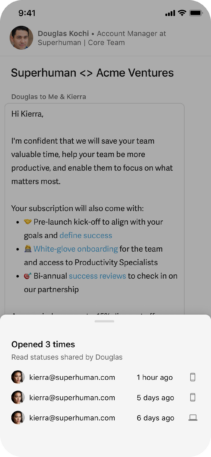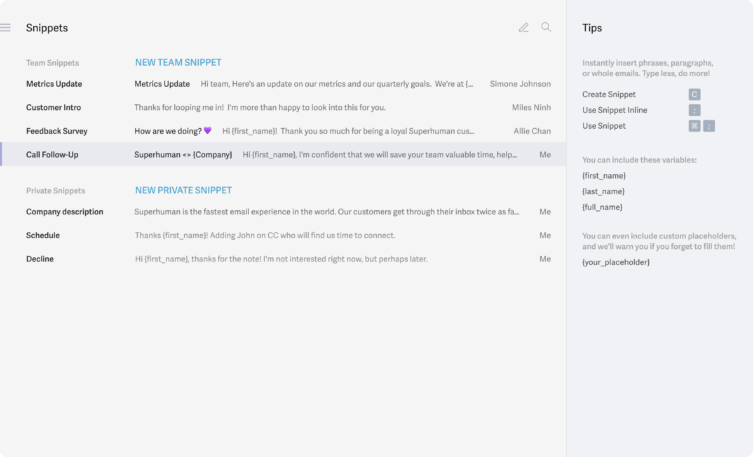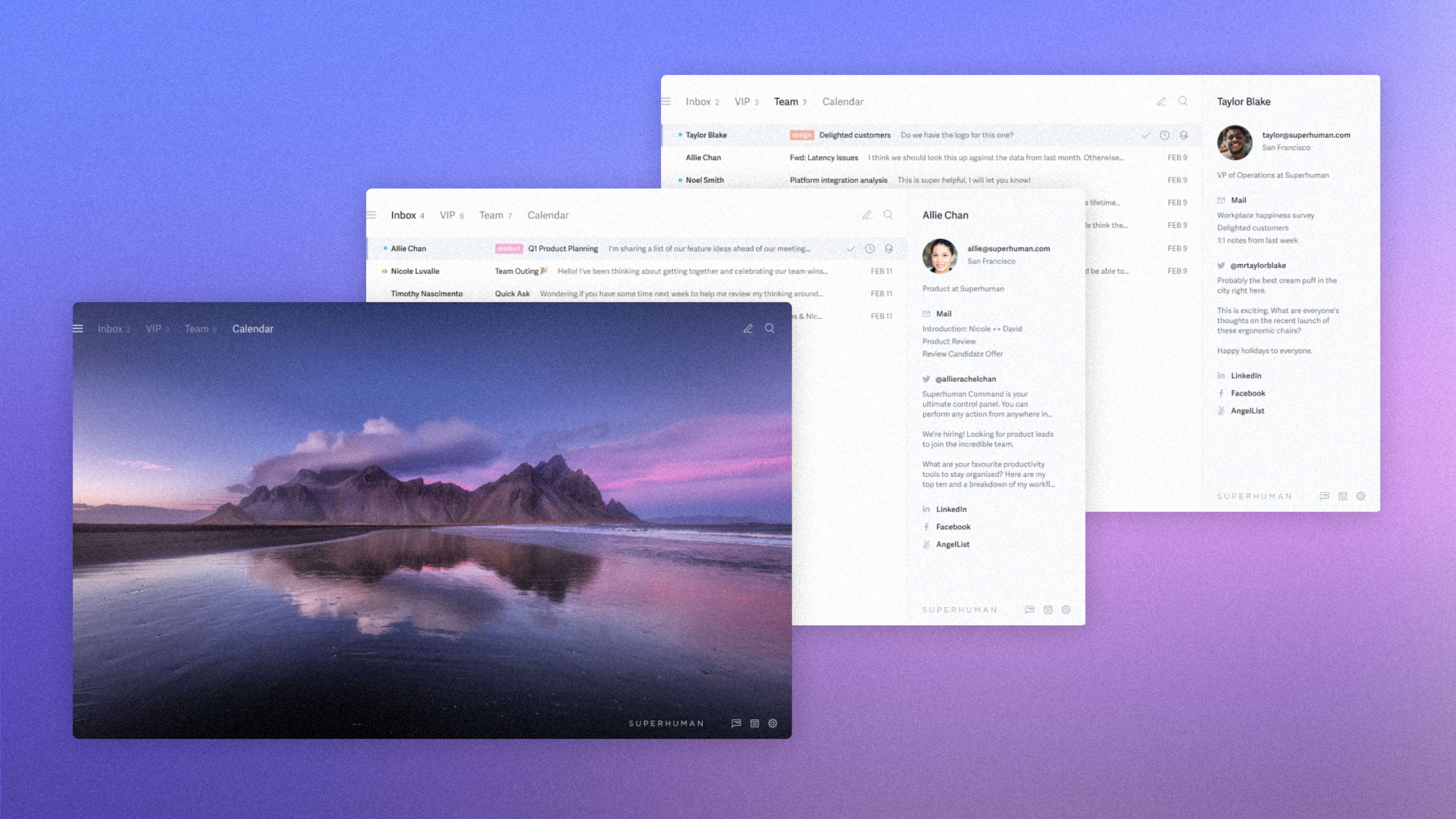Superhuman once had a waitlist of more than 450,000 people hoping to try its $30-per-month email app. Now it’s shifting focus toward companies that might subscribe in bulk.
While the app remains available to individuals—still for $30 per month—Superhuman founder and CEO Rahul Vohra says most of the startup’s growth comes from teams now. This week, it’s leaning into enterprise use with a suite of new collaborative features, including team-wide read receipts, shared text snippets, typing indicators when coworkers are replying to an email, and a group meeting scheduler.
“Email still remains the backbone of business,” Vohra says. “We wouldn’t be sending and receiving so many emails if it wasn’t, and we all go faster when we pull together. So we decided to transform email from pure productivity into smart collaboration.”
A pivot to enterprise was perhaps inevitable for Superhuman, an Andreessen Horowitz-backed startup whose toughest competition is the default Gmail and Outlook apps that people can use for free. But as with any company that shifts attention from individuals to teams, it must now figure out how to accommodate mundane business needs without letting the core product stagnate.

Team effort
Superhuman started offering bulk licenses to companies a couple of years ago, and it counts Uber, Brex, and Notion among its list of customers. But until now, it hasn’t offered any collaborative features for teams in particular.
A couple of the new features are extensions of what Superhuman already offers for individuals. With Snippets, for instance, users can set up blocks of prewritten text with variables such as the recipient’s name. The team version lets coworkers access those snippets as well. And while Superhuman already lets users track whether someone has opened an email, the team version lets coworkers view those read receipts even if they didn’t send the message themselves.
The other new features are a nod to what’s already available outside of Superhuman. Typing indicators should be familiar to anyone who uses Slack or Microsoft Teams—though it may be an even better fit for email, where overlapping replies can be a real nuisance—and team scheduling lets users see everyone’s availability within a message thread, so they don’t have to bounce off to Calendly or Google Calendar.
Vohra says those features are just the beginning. Superhuman is also working on emoji reactions (Google just announced the same for Gmail) and a way to share email threads without forwarding them. Vohra also hints at offering customized versions of its app for different business uses, so sales or recruiting teams might have separate integrations or features.
“There are certain parts of an organization that we want to do a little bit more work for to make the product even better,” he says.

“A long journey”
Vohra says catering to teams was always the goal for Superhuman, but it’s taken a long time to reach a point where he felt it was ready.
“I wanted to build software that people genuinely wanted to use, not software that their manager told them they had to use,” he says. “To me, that meant nailing the single-player use case first.”
Superhuman first opened its waitlist in July 2017, promising to shave hours per week off people’s email routines. It put a big emphasis on keyboard shortcuts—with one-on-one onboarding sessions to help teach those tricks to new users—and encouraged users to split their inboxes into categories, which they can cycle through with the tab key.
Those features aren’t vastly different from what other email apps offer, prompting some reviewers to wonder what the fuss is about. But Vohra argues that Superhuman’s execution is better at saving time.
As examples, he points to the little things that Superhuman has built up over the years, like the “Instant Intro” that moves a recipient to BCC and inserts a custom snippet with one command, or the “Time Auto Completer” that lets users schedule follow-up reminders with natural language.
“I’ve always said that it’s not what we do, it’s how we do it,” he says.
In its early years, Superhuman was famously selective about who it allowed on board, which further lent it a kind of mystique in the tech world. In 2019, Vohra boasted to The New York Times about having a “who’s who of Silicon Valley” among its clientele, and by 2021 it had 450,000 prospective users waiting in line, according to Forbes.
Since then, Superhuman has focused on allowing more people to actually use it. It dropped the waitlist last year and launched Outlook support alongside Gmail. This year, it’s launched native apps for Windows and Android, with Outlook support coming to Android soon. Those additions all helped set the stage for Superhuman’s shift to teams, not all of which are all in on Apple platforms.
“It was a long journey, but we got there, and we now have this thing that no other company in the world has, which is the fastest email experience in the world,” Vohra says.

What’s next for Superhuman users
Vohra points out that the individual side of Superhuman is still growing, if not as quickly as the enterprise side, and the startup still plans to launch more features that might benefit individuals.
A lot of them will be AI-focused. In May, Superhuman launched a suite of AI features, including a way for users to generate emails in their own voice. Of those who’ve opted in to the AI tools, Vohra says 25% use them every week, and 25 times per week on average.
“We’re still going to keep building things like these, and we have a very full hopper of these features alongside our teams road map,” he says.
At the same time, Superhuman will have to juggle a new set of demands that are less exciting than what it’s worked on before. While piloting Superhuman with one prospective partner, Vohra recalls being asked to support things like mobile device management, data loss prevention, and Microsoft Intune. It was a bit of a wake-up call.
“I was like, ‘What is Microsoft Intune?'” he says. “I’ve heard of MDM, and I knew what DLP was, but there were a lot of acronyms and buzzwords going around.”
Vohra says Superhuman will scale those kinds of capabilities up over time, but ultimately he expects the company to spend about half of its efforts on features that are exclusively for teams and the other half on features that might benefit individuals as well.
Of course, I had to ask about pricing. Instead of charging for personal use, a lot of companies give their product away to individuals in hopes that they’ll advocate for it at work. Although Superhuman built a reputation around its price tag, might that change as it pivots toward team use?
Vohra pauses for about eight seconds to think about his response.
“I think the short answer is that we don’t have any plans to change the individual pricing structure,” he says. “But it’s one of those things where I’ll never say never.”
Recognize your brand’s excellence by applying to this year’s Brands That Matter Awards before the final deadline, June 7.
Sign up for Brands That Matter notifications here.
